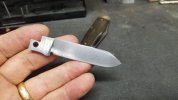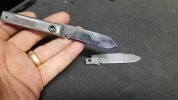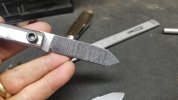 AVigil
AVigil
and
 SBuzek
SBuzek
I realize you guys are probably grinding freehand but as I practice this method myself I'm also using a 4" jig from DD Workrest in conjunction with my 12" wheel. My question is, what are good angles for doing my bevels? I've been using 12* roughly and it seems too steep. I end up reaching the spine way before I get near my center scribe line. Any help is appreciated. Thank you!
Slipjoints follow pretty strict designs and many with specific grind lines people try to follow.
If youre making a blade thats 3/4" tall and the grind you want stops and creates a flat near the spine, the angle is whatever it is to connect those two points. I dont think doing the math is the right way to go.
If the grind goes above the spine, its about how much taper you want. Change your angle to "walk" your grind line in the direction you need, then connecting whatever to points you want, usually your scribed line on your edge and somewhere near the spine by the plunge. If you flat grind to the tip center, your taper is set automatically.
I hope that makes sense. Jigs, if you use them, seem more to me about holding a consistent, arbitrary angle to what your're trying to achieve with your grind line but I've always freehand ground so I dont have as much experience with them. Angles specific make sense in some sharpening activities .
Without a jig you do this a bit by feel where the belt is digging and also by watching the tiny sliver shadow between the belt and edge if it is there, at least thats the odd method I've developed over the years.
I dont use a stick. Burned fingers are punishment for grinding too hot and I accept that punishment

Lots of folder makers grind post HT but I've never really been able to do it and felt I was eating belts and worrying about heat a bit too much. I pregrind the swedges and almost finish them to final grit pre-HT. Everything else I leave thicker than I would a fixed blade but my main bevels are set, grind lines maybe 1/4" below where I want them to end. Nail nick goes in pre-HT as well.




